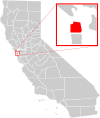
The F Market & Wharves line is one of several light rail lines in San Francisco, California. Unlike most other lines in the system, the F line runs as a heritage streetcar service, almost exclusively using historic equipment from San Francisco's retired fleet and from cities around the world. While the F line is operated by the San Francisco Municipal Railway (Muni), its operation is supported by Market Street Railway, a nonprofit organization of streetcar enthusiasts which raises funds and helps to restore vintage streetcars.

Embarcadero station is a combined BART and Muni Metro rapid transit subway station in the Market Street subway in downtown San Francisco. Located under Market Street between Drumm Street and Beale Street near The Embarcadero, it serves the Financial District neighborhood and surrounding areas. The three-level station has a large fare mezzanine level, with separate platform levels for Muni Metro and BART below. Embarcadero station opened in May 1976 – almost two years after service began through the Transbay Tube – as an infill station.
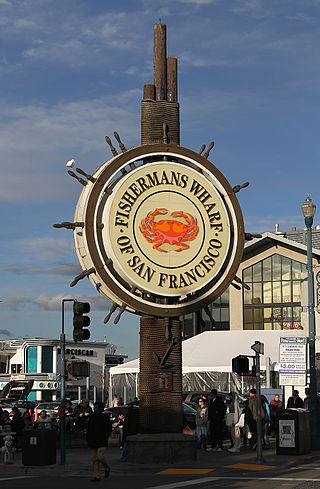
Fisherman's Wharf is a neighborhood and popular tourist attraction in San Francisco, California, United States. It roughly encompasses the northern waterfront area of San Francisco from Ghirardelli Square or Van Ness Avenue east to Pier 35 or Kearny Street. The F Market streetcar runs through the area, the Powell / Hyde cable car used to line runs to Aquatic Park, at the edge of Fisherman's Wharf, and the Powell / Mason cable car line runs a few blocks away in the past.

The Third Street Light Rail Project was the construction project that expanded the Muni Metro system in San Francisco, California, linking downtown San Francisco to the historically underserved southeastern neighborhoods of Bayview-Hunters Point and Visitacion Valley along the eastern side of the city. Construction was finished in late 2006, non-revenue weekend service began on January 13, 2007, and full service began on April 7, 2007. The new service, as the T Third Street Metro line, replaced the 15 Third bus line, which ran south from the Caltrain Depot at 4th and King streets, along Third Street and Bayshore Boulevard to the southeastern neighborhoods.
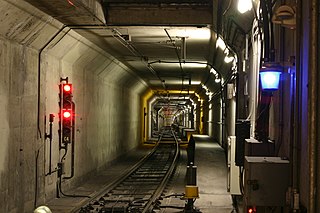
The Market Street subway is a two-level subway tunnel that carries Muni Metro and BART trains under Market Street in San Francisco, California. It runs under the length of Market Street between Embarcadero station and Castro station. The upper level is used by Muni Metro lines and the lower level is used by BART lines. BART does not run through the whole subway; it turns south and runs under Mission Street southwest of Civic Center/UN Plaza station. The northeastern end of the BART level is connected to the Transbay Tube. On the Muni Metro level, the southwestern end of the Market Street subway connects to the much-older Twin Peaks Tunnel, and the northeastern end connects to surface tracks along the Embarcadero.
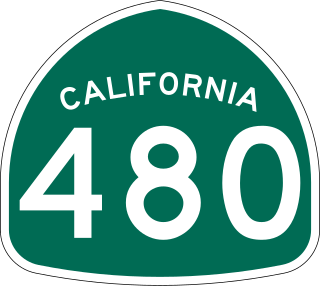
State Route 480 was a state highway in San Francisco, California, United States, consisting of the elevated double-decker Embarcadero Freeway, the partly elevated Doyle Drive approach to the Golden Gate Bridge and the proposed and unbuilt section in between. The unbuilt section from Doyle Drive to Van Ness Avenue was to have been called the Golden Gate Freeway and the Embarcadero Freeway as originally planned would have extended from Van Ness along the north side of Bay Street and then along the Embarcadero to the San Francisco-Oakland Bay Bridge.

The San Francisco Ferry Building is a terminal for ferries that travel across the San Francisco Bay, a food hall and an office building. It is located on The Embarcadero in San Francisco, California and is served by Golden Gate Ferry and San Francisco Bay Ferry routes.

The San Francisco Belt Railroad was a short-line railroad along the Embarcadero in San Francisco, California. It began as the State Belt Railroad in 1889, and was renamed when the city bought the Port of San Francisco in 1969. As a state owned enterprise, the railroad asserted several unsuccessful claims to immunity from federal regulation. The railroad ceased operation in 1993.

People in the San Francisco Bay Area rely on a complex multimodal transportation infrastructure consisting of roads, bridges, highways, rail, tunnels, airports, seaports, and bike and pedestrian paths. The development, maintenance, and operation of these different modes of transportation are overseen by various agencies, including the California Department of Transportation (Caltrans), the Association of Bay Area Governments, San Francisco Municipal Transportation Agency, and the Metropolitan Transportation Commission. These and other organizations collectively manage several interstate highways and state routes, eight passenger rail networks, eight trans-bay bridges, transbay ferry service, local and transbay bus service, three international airports, and an extensive network of roads, tunnels, and bike paths.

The Port of San Francisco is a semi-independent organization that oversees the port facilities at San Francisco, California, United States. It is run by a five-member commission, appointed by the Mayor subject to confirmation by a majority of the Board of Supervisors. The Port is responsible for managing the larger waterfront area that extends from the anchorage of the Golden Gate Bridge, along the Marina district, all the way around the north and east shores of the city of San Francisco including Fisherman's Wharf and the Embarcadero, and southward to the city line just beyond Candlestick Point. In 1968, the State of California, via the California State Lands Commission for the State-operated San Francisco Port Authority, transferred its responsibilities for the Harbor of San Francisco waterfront to the City and County of San Francisco / San Francisco Harbor Commission through the Burton Act AB2649. All eligible State port authority employees had the option to become employees of the City and County of San Francisco to maintain consistent operation of the Port of San Francisco.

The E Embarcadero is a historic streetcar line that is the San Francisco Municipal Railway's second heritage streetcar line in San Francisco, California. Trial service first ran during the Sunday Streets events on The Embarcadero in 2008. The line initially ran on weekends only, but expanded to weeklong service in late April 2016.

Market Street Railway is San Francisco Municipal Railway's (Muni) 1,200-member non-profit preservation partner. It relies on private contributions to help maintain San Francisco’s fleet of historic streetcars in service on the E Embarcadero and F Market & Wharves lines.
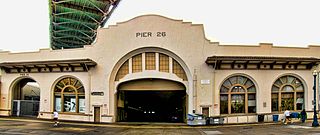
The existing historic Pier 26 in San Francisco is located on the Embarcadero with its entrance directly under the San Francisco–Oakland Bay Bridge, several blocks southeast of the Ferry Building. The pier is a single story gable timber structure that rests partially on concrete retainage but mostly on pier foundations on the bay. Its surface area measures approximately 100,000 square feet (9,300 m2), currently used for parking and storage. Its front facade along the Embarcadero is of historic significance. The United States Geological Survey treats the entrance of Pier 26 on the Embarcadero as the location of Rincon Point, though the Embarcadero is built on land fill and the historical location was slightly to the northwest.

The Central Embarcadero Piers Historic District is a Registered Historic District in the city of San Francisco, California, United States. It consists of Piers 1, 1½, 3 and 5, which form one of the largest surviving pier complexes along San Francisco's Embarcadero waterfront road. It was added to the National Register of Historic Places in 2002.
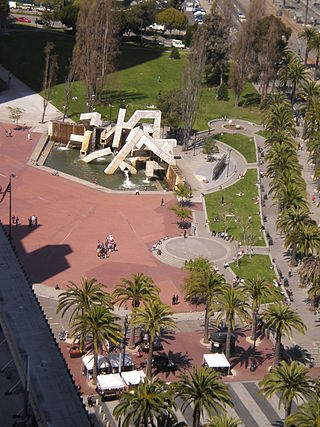
Embarcadero Plaza, previously known as Justin Herman Plaza from its opening in 1972 until 2017, is a 1.23-acre (0.50 ha) plaza near the intersection of Market and Embarcadero in San Francisco's Financial District, in the U.S. state of California. It is owned by Boston Properties, who acquired the neighboring Embarcadero Center office, hotel, and retail complex in 1998.

The Embarcadero and Bay station is a streetcar station in San Francisco, California, serving the San Francisco Municipal Railway's E Embarcadero and F Market & Wharves heritage railway lines. It is located on The Embarcadero at Bay Street. The station opened on March 4, 2000, with the streetcar's extension to Fisherman's Wharf.
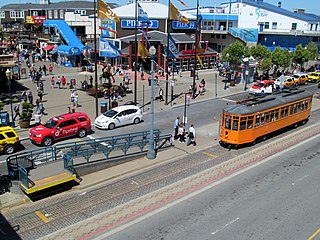
The Embarcadero and Stockton station is a light rail station in the Fisherman's Wharf district of San Francisco, California, serving the San Francisco Municipal Railway's E Embarcadero and F Market & Wharves heritage railway lines. It is located on The Embarcadero at Stockton Street, in front of Pier 39. The station opened on March 4, 2000, with the streetcar's extension to Fisherman's Wharf.

Jefferson and Powell station is a light rail station in the Fisherman's Wharf district of San Francisco, California, serving the San Francisco Municipal Railway's E Embarcadero and F Market & Wharves heritage railway lines. It is located on Jefferson Street at Powell Street. The station opened on March 4, 2000, with the streetcar's extension to Fisherman's Wharf.

Cupid's Span is an outdoor sculpture by married artists Claes Oldenburg and Coosje van Bruggen, installed along the Embarcadero in San Francisco, California, in the United States. The 70-foot (21 m) sculpture, commissioned by Gap Inc. founders Donald and Doris F. Fisher, depicts a partial bow and piece of an arrow.


























